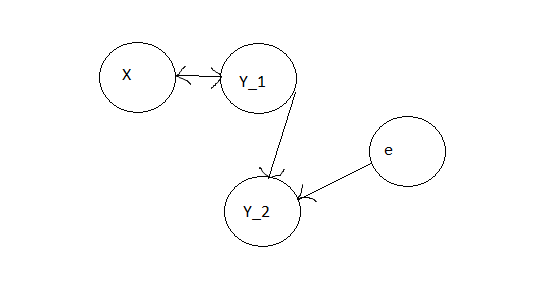We can use a graphical model to answer questions like this. I just made this in MS paint so it doesn't look very nice, but the idea should be clear. I also renamed your $E$ as $e$ just so there's no confusion with the expectation operator if that gets involved.
If I've understood your question correctly, we have that $X$ and $Y_1$ are dependent, so there is an edge connecting them. We also have that $Y_2$ is correlated with $Y_1$ and $e$ so there are those two edges. There are no other dependencies. I used a directed graphical model because it seems like you want to view $Y_2$ as being "caused" by $Y_1$ and $e$.
You really want to know if $X \perp Y_1 \vert Y_2$. Looking at the graphical model, we can say that this is not the case. Cover up the node representing $Y_2$: there is still a pathway between $X$ and $Y_1$. That means that there is still a relationship between $X$ and $Y_1$ even when $Y_2$ is known.
This can all be made much more rigorous if you are looking to make this a proof.
Update: here's a counterexample using first principles.
I did this pretty quickly so I apologize if there are any mistakes. I'll review it soon.
Let's say $\vec Z := (X, Y, e) \sim \mathcal N_3(\vec 0, \Sigma)$ where $$ \Sigma = \left[ {\begin{array}{ccc} 1 & \rho & 0\\ \rho & 1 & 0 \\ 0&0&1 \end{array} } \right] $$
so that $X$ and $Y$ are correlated and both are independent of $e$.
Now let $ \vec T := (U, V, W) = (X, Y, Y + e)$. This is a linear transformation so we don't need to worry about a Jacobian, and we simply get $$ f_{\vec T}(u, v, w) = f_{\vec Z}(u, v, w-v). $$
We know that $$ f_{\vec T}(t) = \frac{1}{(2\pi)^{3/2} \vert \Sigma \vert ^{1/2}} \exp \left(-\frac{1}{2} t^T \Sigma^{-1} t\right) $$ (since the mean is $\vec 0$ still) so we can just work out what this is. I used Wolfram alpha to do this so it was pretty easy.
$$ f_{(U,V,W)}(u,v,w) \propto \exp \left( \frac{u^2}{1-\rho^2} + 2 \frac{uv\rho}{1-\rho^2} + \frac{v^2}{1-\rho^2} + (w-v)^2 \right). $$
In order for $X \perp Y \vert Y + e$, we need this to factor so that there are no terms involving both $U$ and $V$. It seems clear that this is impossible when $\rho \neq 0$, and so we have a counterexample to the claim that $X \perp Y \vert e$.

